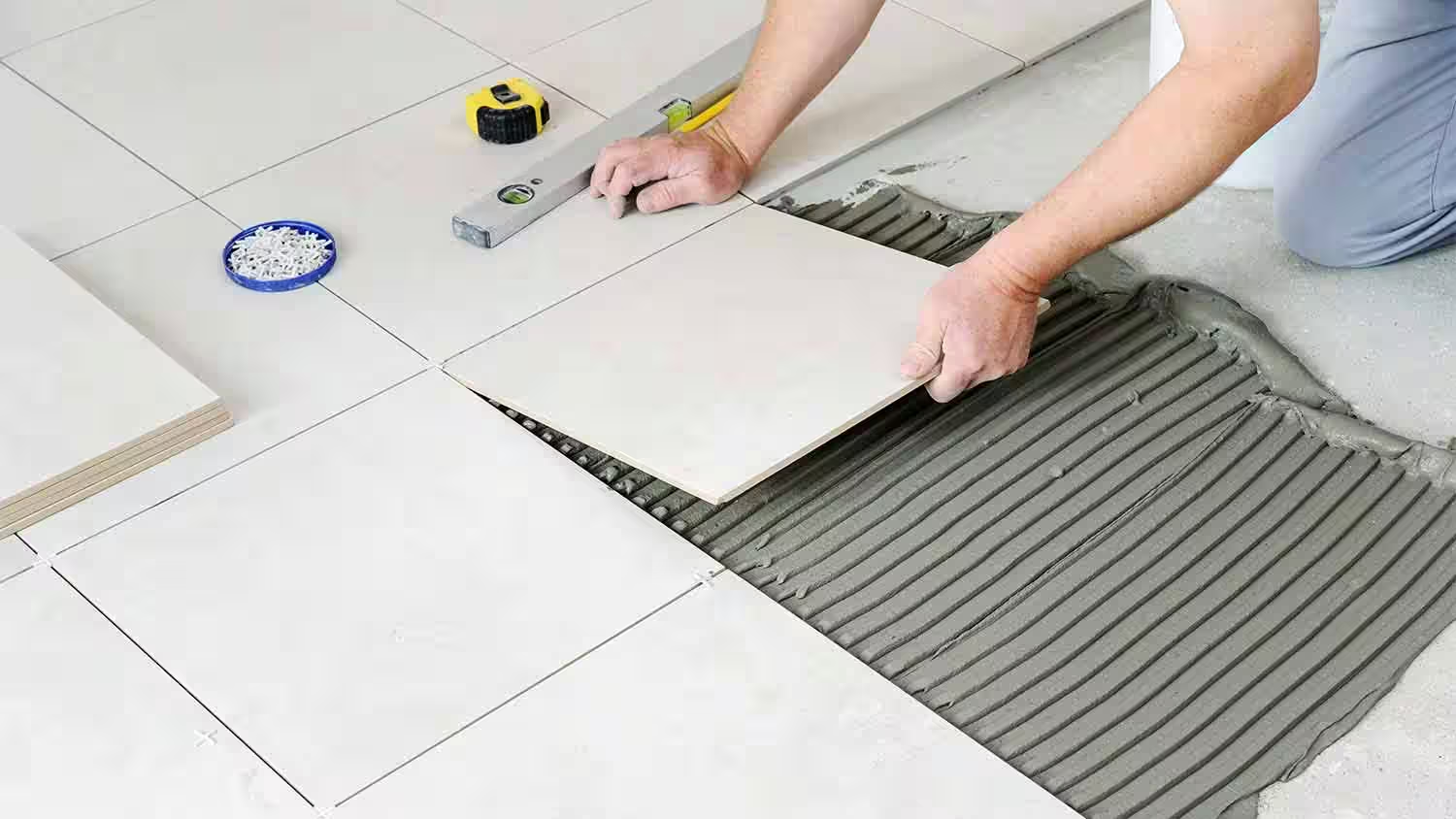
Everything You’ll Need
| Tool / Material | Ceramic Tile | Porcelain Tile | Purpose | |||||||||||||||||||||||
|---|---|---|---|---|---|---|---|---|---|---|---|---|---|---|---|---|---|---|---|---|---|---|---|---|---|---|
| Tape Measure | ✔ | ✔ | Measure room size and tile gaps | |||||||||||||||||||||||
| Chalk Line | ✔ | ✔ | Mark center lines and guide lines | |||||||||||||||||||||||
| Straight Edge | ✔ | ✔ | Guide straight cuts | |||||||||||||||||||||||
| Pry Bar | ✔ | ✔ | Remove old flooring | |||||||||||||||||||||||
| Spacers | ✔ | ✔ | Keep grout gaps even | |||||||||||||||||||||||
| Notched Trowel | ✔ | ✔ | Spread mortar on floor | |||||||||||||||||||||||
| Mixing Paddle & Drill | ✔ | ✔ | Mix mortar and grout | |||||||||||||||||||||||
| Wet Saw or Tile Cutter | ✔ | ✔ | Cut tiles for edges | |||||||||||||||||||||||
| Utility Knife | ✔ | ✔ | Trim underlayment | |||||||||||||||||||||||
| Level | ✔ | ✔ | Ensure tiles are flat | |||||||||||||||||||||||
| Grout Float | ✔ | ✔ | Apply grout at angle | |||||||||||||||||||||||
| Bucket & Sponge | ✔ | ✔ | Clean tiles and grout | |||||||||||||||||||||||
| Knee Pads | ✔ | ✔ | Protect knees on floor | |||||||||||||||||||||||
| Safety Glasses | ✔ | ✔ | Protect eyes while cutting | |||||||||||||||||||||||
| Gloves | ✔ | ✔ | <td data-col-size="md" data-start="2037" data-end
| Installation Method | Best For | Strength & Durability | DIY Friendliness | Notes |
|---|---|---|---|---|
| Thinset Mortar | Floor tiles, wet places (bathrooms, kitchens), big spaces | ⭐⭐⭐⭐⭐ (Excellent) | Moderate | Standard for tile floors. Handles water, weight, and movement. |
| Tile Adhesive (Mastic) | Small dry places, wall tiles | ⭐⭐ (Limited) | Easy | Not good for floor tiles or wet areas. Quick to apply but less durable. |
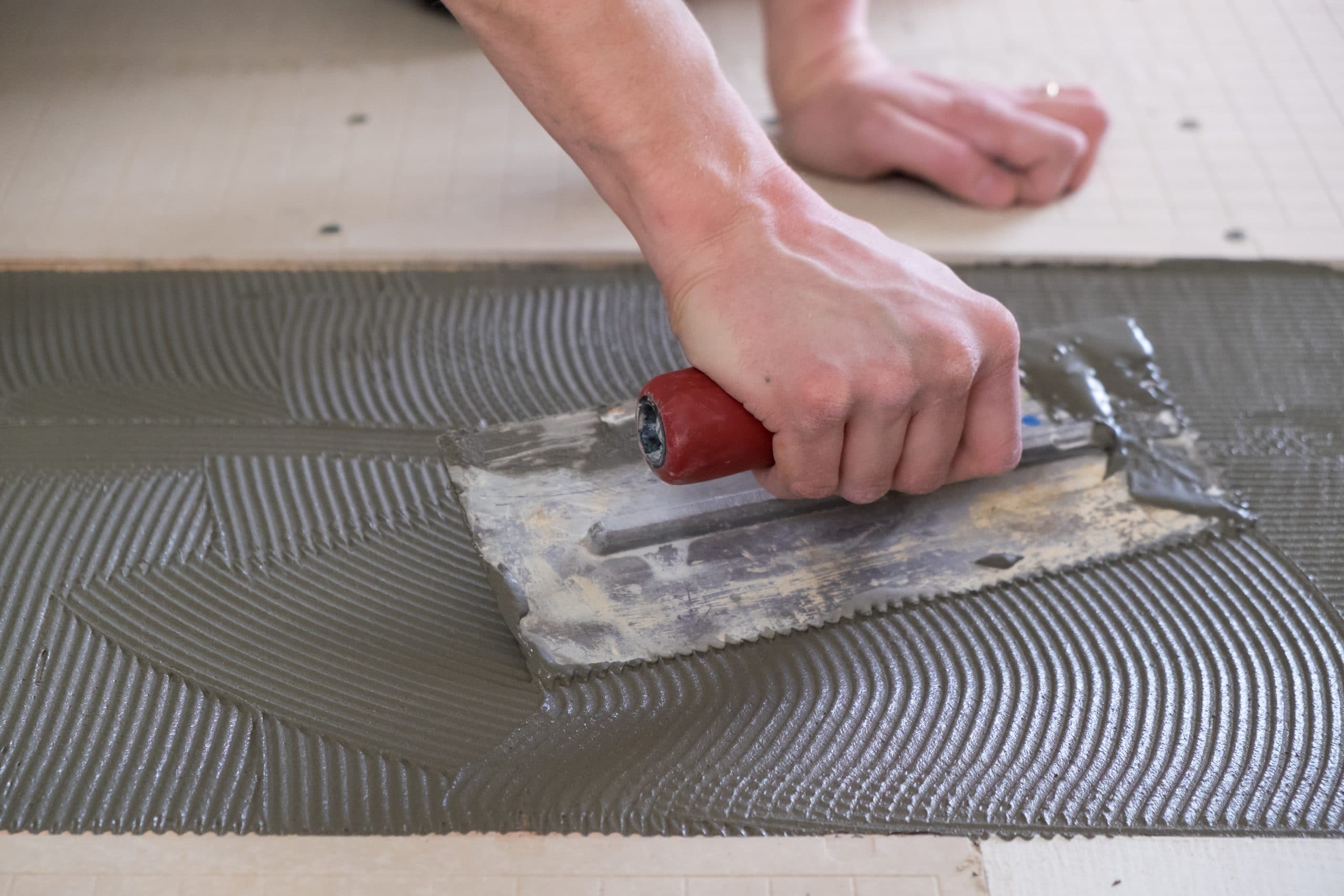
Step 4: Mix Mortar and Apply to Subfloor
Mix the Mortar
Start by mixing the thinset mortar as instructed on the package. Use a clean bucket and a drill with a mixing paddle to make it smooth and lump-free. Let it rest for a short time, then mix again before using.
Spread the Mortar
Use a notched trowel to spread the mortar evenly over a small area of the floor. Hold the trowel at a 45-degree angle to form even ridges. These ridges help the tile stick properly and maintain the right level.
Work in Small Sections
Only cover as much floor as you can tile in about 10–15 minutes. This prevents the mortar from drying before placing the tiles.
Pro Tip:
For larger tiles, apply a thin layer of mortar on the back for better adhesion, especially for tiles over 12 inches.
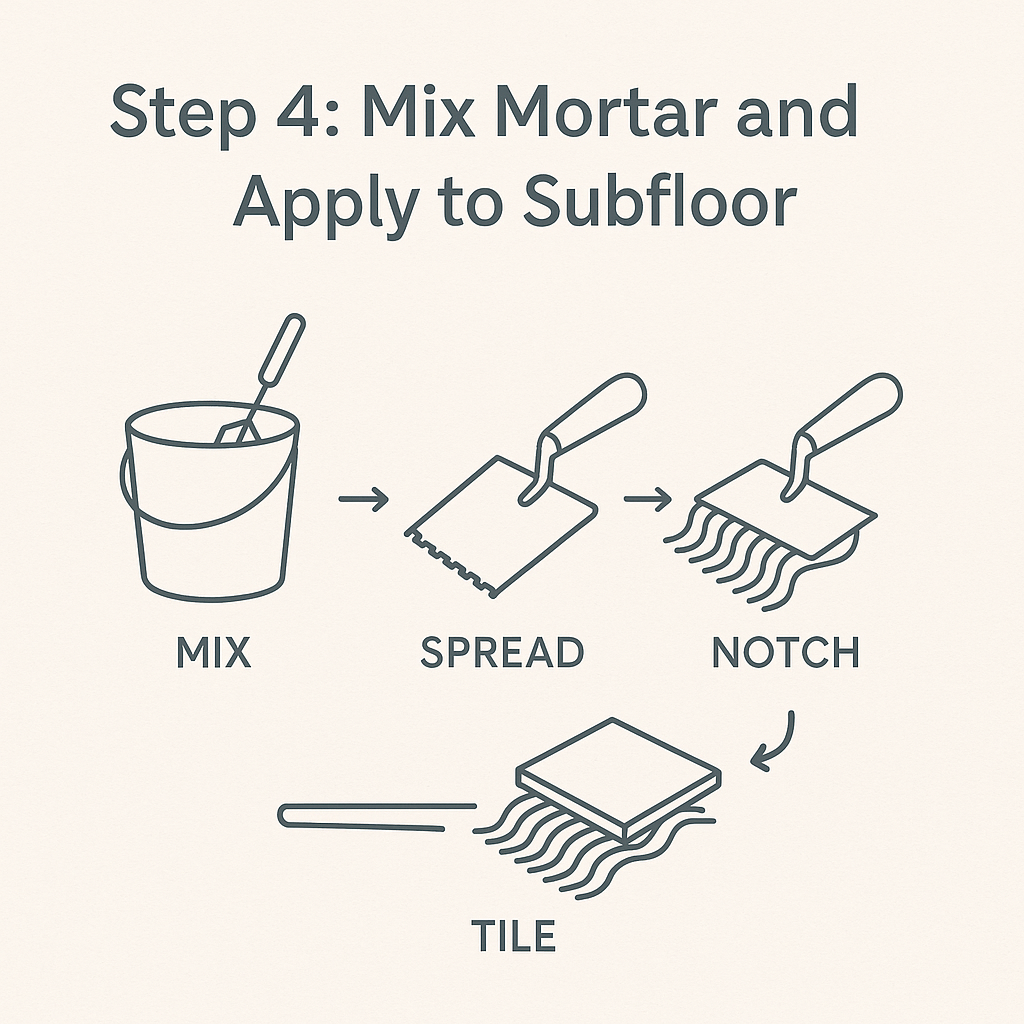
Step 5: Lay the First Tiles
Starting right helps the whole project go well.
Begin at the Center
Use chalk lines to start at the room’s center. This ensures tiles are placed evenly.
Place the First Tile
Put the first tile in the mortar. Press down and twist a bit so it sticks well.
Use Tile Spacers
Place spacers between tiles for even gaps. This makes a tidy finish.
Check Level
After a few tiles, use a level to make sure the surface is flat. Adjust if needed before mortar dries.
Tip:
Work in small areas to prevent the mortar from drying too fast!
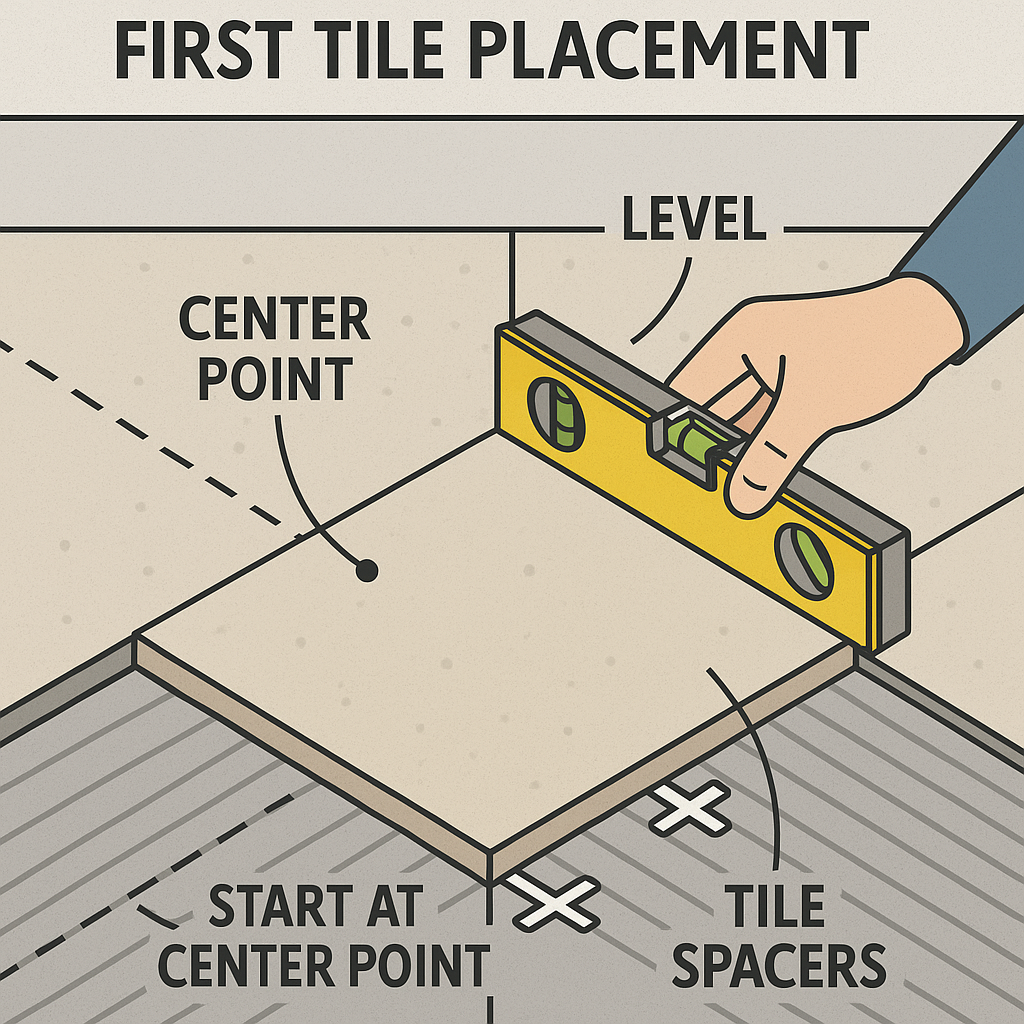
Step 6: Cutting Tiles to Fit
Accurate tile cutting is key for a clean look.
Measure and Mark
Use a tape to measure the tile size you need. Mark the cut line with a pencil.
Select the Right Tool
For straight cuts, a manual tile cutter works well.
For curved or detailed cuts, use a wet saw or an angle grinder with a diamond blade.
Cut in a Safe Spot
Cut outside or in an airy area to avoid dust. Wear safety glasses and gloves for protection.
Pro Tip:
Measure twice to avoid mistakes and ensure a perfect fit!
Step 7: Install Remaining Tiles and Let Mortar Cure
Start by putting down the first tiles, then lay each tile one row at a time. Begin where you planned and use spacers to keep grout lines straight. Check often to make sure tiles are level and adjust to prevent bumpy surfaces.
As you lay tiles, don’t step on the new ones to stop them from moving. Work in small areas that you can handle so the glue doesn’t dry before you finish placing the tiles.
After all tiles are placed, let the glue set for at least 24 hours (or follow what the maker suggests) before grouting. Letting it set right is important for a strong and long-lasting tile floor.
Step 8: Apply Grout
After the mortar dries, grout the gaps between the tiles:
Mix the Grout
Follow the package instructions to mix the grout until it’s like creamy peanut butter.Spread Grout Using a Float
Use a rubber float at a 45° angle to apply grout over the tiles, pressing firmly to fill gaps.Remove Excess Grout
Once filled, tilt the float steeply and scrape away extra grout from the tiles.Clean the Tiles with a Damp Sponge
After 10 to 15 minutes, gently clean tiles with a damp sponge. Rinse often and keep grout intact.Final Buffing
When a haze forms on the grout (30–60 minutes later), use a dry microfiber cloth to polish the tiles and remove the haze.
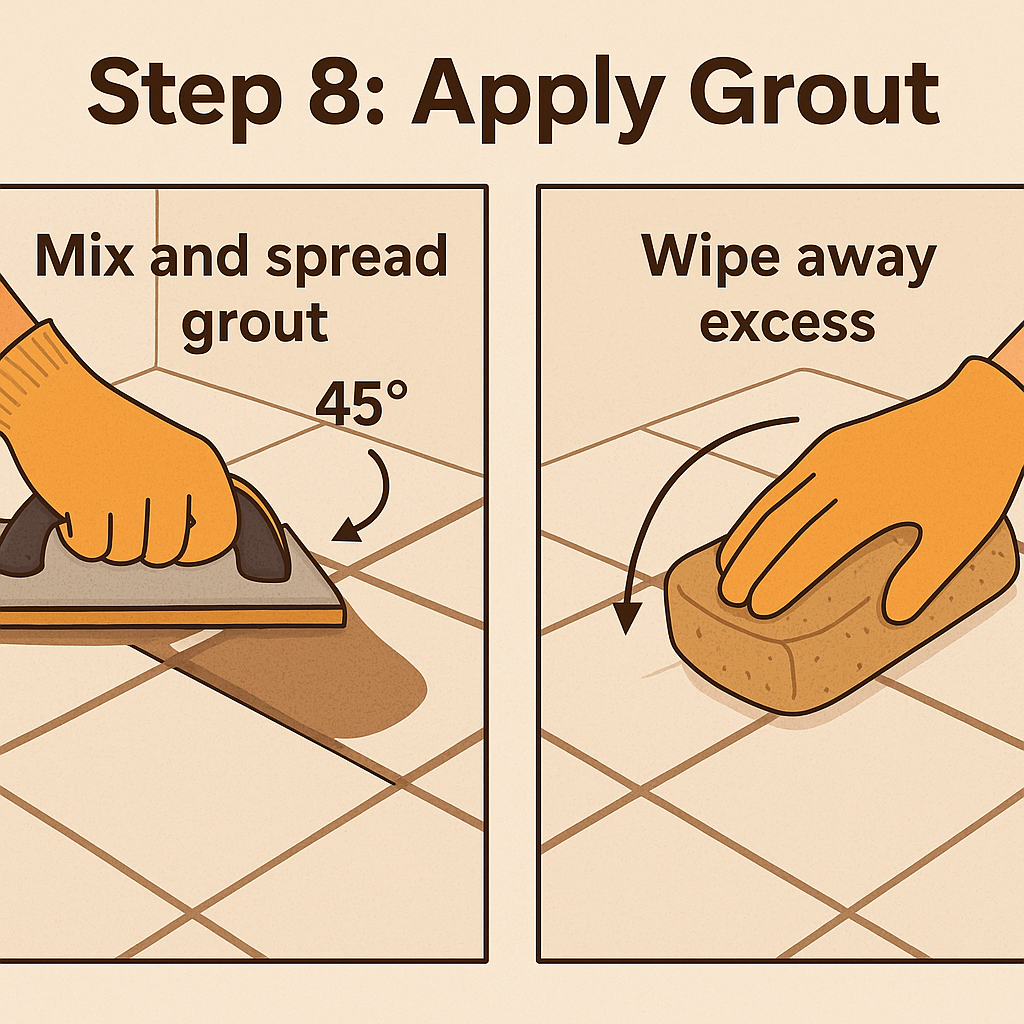
Step 9: Clean and Seal the Floor
Clean Grout Haze
After grout dries (usually 1 to 2 days), a haze may appear on tiles. Clean the tiles gently with a damp sponge or grout haze remover, avoiding grout lines.
Seal the Grout
If suggested, apply a grout sealer to protect from moisture, stains, and mold. Use a small brush or roller tip bottle for careful application. Allow the sealer to dry completely as instructed.
Put Back Baseboards and Strips
Once clean and dry, reinstall baseboards and add transition strips between different floors or rooms. This makes the tile floor appear neat and professional.
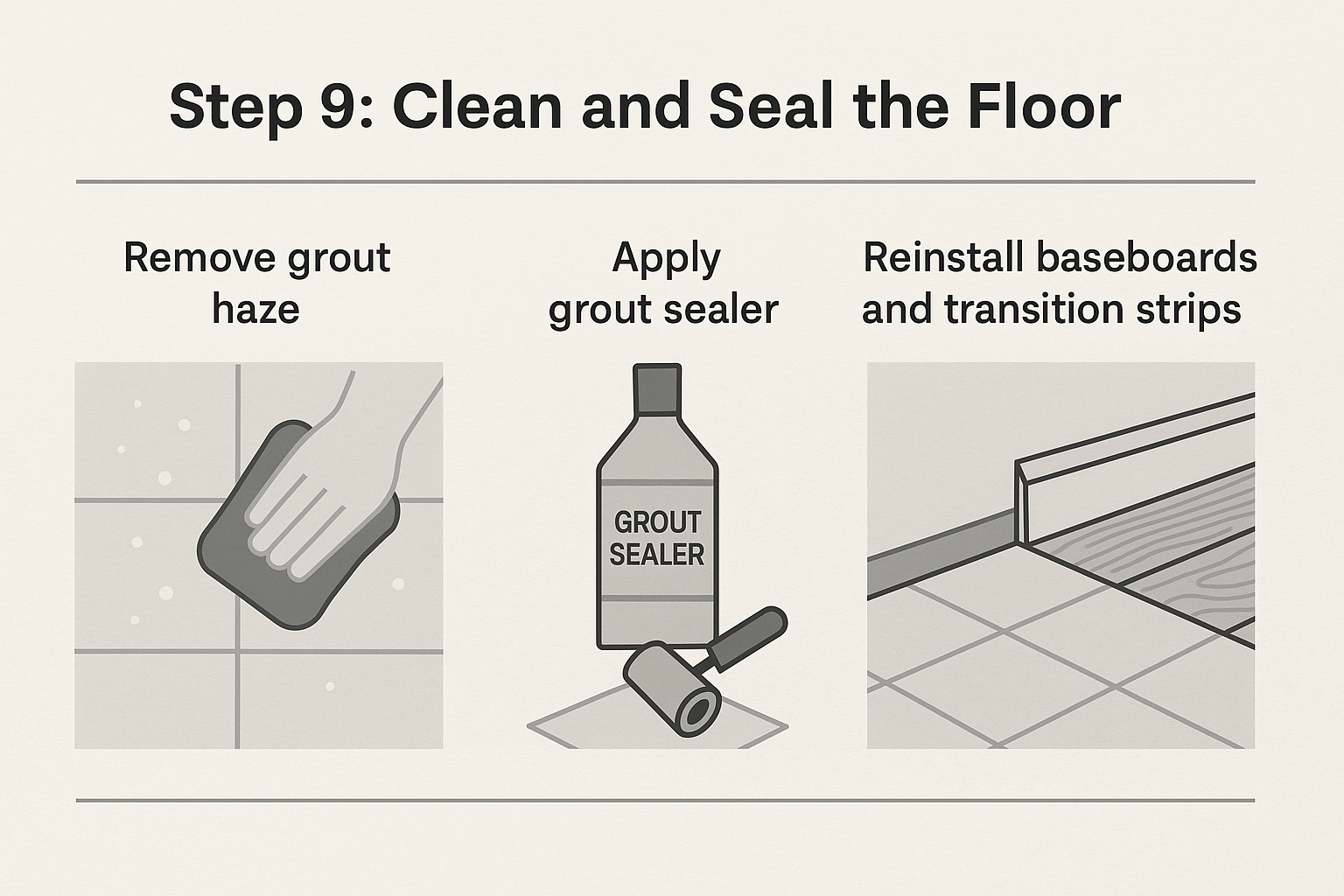
DIY vs. Professional Tile Installation
Doing tile floors yourself can save money, but it may not be the best option. Here’s how to decide if you should do it yourself or hire a professional.
DIY Pros
Lower starting cost
Work at your own pace
Great for small, simple spaces like bathrooms
DIY Cons
Requires time and special tools
Mistakes can be costly
Challenging for large or complex layouts
Professional Installation Pros
Expert work with lasting results
Faster completion, especially for large areas
Includes prep, cutting, and cleanup
Usually includes warranties
Professional Installation Cons
Higher initial cost
Less control over timing
Cost Comparison
Here’s what you might pay:
| Installation Type | Average Cost per Sq Ft | Typical Total for 250 Sq Ft |
|---|---|---|
| DIY Installation | $2 – $8 (materials + rental tools) | $500 – $2,000 |
| Professional Installation | $8 – $25 | $2,000 – $6,250 |
👉 For more details, see our Tile Flooring Cost Guide.
Pro Tips for a Successful Tile Flooring Installation
Want your DIY tile project to turn out great? Remember these tips:
Save time by preparing tools and tiles first. Keep them nearby.
Use a quality wet saw for clean cuts, especially with porcelain tiles.
Mix small batches of mortar and grout. This prevents them from drying too quickly.
Check the level often using a spirit level when laying tiles.
Work in small areas. This stops the mortar from drying before placing tiles.
Reduce breakage. Cut tiles slowly and wear safety glasses.
Avoid These Mistakes When Installing Tile Flooring
Even experts can make these common mistakes:
Not leveling the subfloor. Uneven floors can crack tiles and ruin lines.
Not using spacers. This can make grout lines appear messy.
Walking on tiles too soon. This can shift tiles and mess up alignment.
Using too much or too little mortar. This affects how well tiles stick or sit.
Not cleaning grout haze quickly. Waiting makes it harder to remove.
Do You Need Professional Help With Your Tile Flooring Installation Project?
You’ve learned how to install tile flooring step-by-step, creating a strong, beautiful surface. If you’d like experts to handle the job, we’re ready to help.
Our skilled flooring installation team manages everything — from subfloor prep to laying and sealing tiles — for a perfect result. We’ll guide you in choosing the right tile style and materials for your needs and budget.
Contact us today to schedule your free consultation at your home and see if we serve your area!
Request a consultation
Meet with one of our skilled project specialists to get started
2103 Meridian Blvd, Warrington, PA 18976 | (267) 486-9976
Company
Products
Get In Touch
White Glove Flooring
2103 Meridian Blvd, Warrington, PA 18976
(267) 486-9976





